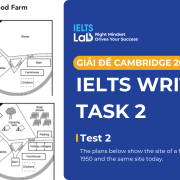Nhận thấy còn nhiều bạn đang hoang mang và lo lắng khi chuẩn bị cho kỳ thi IELTS Speaking, đội ngũ học thuật tại IELTS Lab đã biên soạn câu trả lời cho bộ đề dự đoán IELTS Speaking Forecast quý 3 (tháng 9-12) năm 2025. Có thể nói đây chính là một bước tiến lớn trong việc giúp bạn đạt được điểm cao và tự tin khi nói trước giám khảo.
Đội ngũ học thuật tại IELTS Lab đã tận dụng kiến thức và kinh nghiệm của mình để cung cấp cho bạn câu trả lời chi tiết cho hơn 70 chủ đề khác nhau trong bộ dự đoán IELTS Speaking Forecast. Mỗi câu trả lời được biên soạn một cách tỉ mỉ và logic, giúp bạn phát triển khả năng trả lời một cách tự tin và chính xác.

📌 Tải bộ đề IELTS Speaking Tại đây
👉 Chi tiết cách học và tận dụng tài liệu Forecast speaking, đặc biệt phần gộp đề sẽ được dạy chi tiết trong lớp Luyện Đề Cấp tốc quý 3 – GV đứng lớp: thầy Lê Hoà 8.0 Speaking

Thông tin lớp học và lịch khai giảng
I. Một vài chủ đề khó trong đề thi IELTS Speaking quý 3 này
Speaking Part 3:
- Should all scenic spots charge an entry fee?
Not necessarily. I think it depends on how the money is used. If the entry fee helps maintain the site, protect the environment, or support local communities, then it’s completely reasonable. But when places charge high fees mainly for profit, it can discourage people from visiting, especially local residents. Ideally, there should be a balance – small fees that ensure proper maintenance but still make the sites accessible to everyone. After all, nature and cultural heritage should be something that people can enjoy without too many financial barriers.
- Is visiting scenic spots the best choice for us while travelling?
It’s certainly one of the most popular choices, but I wouldn’t say it’s the only “best” one. Scenic spots give travelers a sense of beauty and relaxation, but traveling can also be about learning new cultures, trying local food, or interacting with local people. For me, the most rewarding trips are those that mix both – you visit beautiful places, but you also get to understand the lifestyle and values of the people living there. So scenic attractions are great, but they’re just one part of a meaningful travel experience.
- Why do some people like to live in big cities?
I think it mainly comes down to convenience and opportunity. Cities usually offer better jobs, education, and healthcare, and they’re full of entertainment options and social activities. For ambitious people, urban areas are where things happen – where they can grow professionally and personally. That said, city life can be stressful and competitive, but many people are willing to trade peace and quiet for the excitement and possibilities that come with a fast-paced urban lifestyle.
- Is it necessary for tourists to visit landmarks when travelling in a place?
I wouldn’t say it’s necessary, but it’s definitely worthwhile. Landmarks often represent the history and identity of a place, so visiting them helps tourists understand the local culture on a deeper level. However, if you only stick to the famous attractions, you might miss out on the more authentic side of local life. Personally, I like to visit a few landmarks for context, but I also enjoy exploring hidden corners or local markets where I can experience how people actually live. That’s where the real charm often lies.
- Which do most people prefer, living in a bungalow or in a tall building?
It really depends on people’s lifestyle and priorities. In big cities, most people live in high-rise apartments simply because space is limited and land is expensive. Tall buildings also offer better security and modern facilities. However, many still dream of living in a bungalow because it feels more private, spacious, and closer to nature. In the end, it’s a trade-off – apartments are practical, while bungalows provide comfort and a sense of freedom that city life often lacks.
Gộp đề part 2
1. Describe an interesting building you saw during a trip
2. Describe an interesting traditional story
– Giới thiệu chủ đề: I once had a trip to Ha Giang – where I got to see an ancient traditional house, and learn
something about its origin. So, I’ll talk about it for this topic.
– Miêu tả nơi này: Okay, first let me say something about Ha Giang: it is a province in northern Vietnam, well-
known for its stunning mountainous landscape covered with lush forests.
+ Visitors are often encouraged to travel through the winding mountain passes to explore local wonders like
buckwheat fields, ancient villages, and traditional markets.
– Liên hệ: What impressed me the most was a visit to a traditional stilt house that still retains all of its
original architecture. The house was made of natural materials, with a wooden stilt system and a thatched
roof.
+ There, my friends and I met our tour guide, who took us around and explained some interesting artifacts.
I still remember a fascinating story she told us — about the origin of the stilt house.
+ (Câu truyện) According to the tale, the area used to be constantly threatened by natural disasters and wild
beasts, so people had to live in caves for a long time. Feeling sorry for them, a goddess descended and taught
them how to build stilt houses — with tall stilts to avoid floods and animals, and steep thatched roofs to let
rainwater run off easily.
From then on, people lived safely and happily, and they carved a special symbol on the front door to
commemorate the goddess.
II. Lời kết
Hãy chia sẻ bộ đề này với các thí sinh khác để cùng nhau hỗ trợ và giúp đỡ trong quá trình chuẩn bị cho kỳ thi sắp tới. Đội ngũ IELTS Lab tin rằng, với sự chuẩn bị chu đáo và tài liệu chất lượng như IELTS Speaking Forecast quý 3 năm 2025, bạn sẽ đạt được kết quả xuất sắc trong bài thi IELTS của mình. Cảm ơn bạn đã tin tưởng và ủng hộ IELTS Lab! 🎯📖


















Trả lời